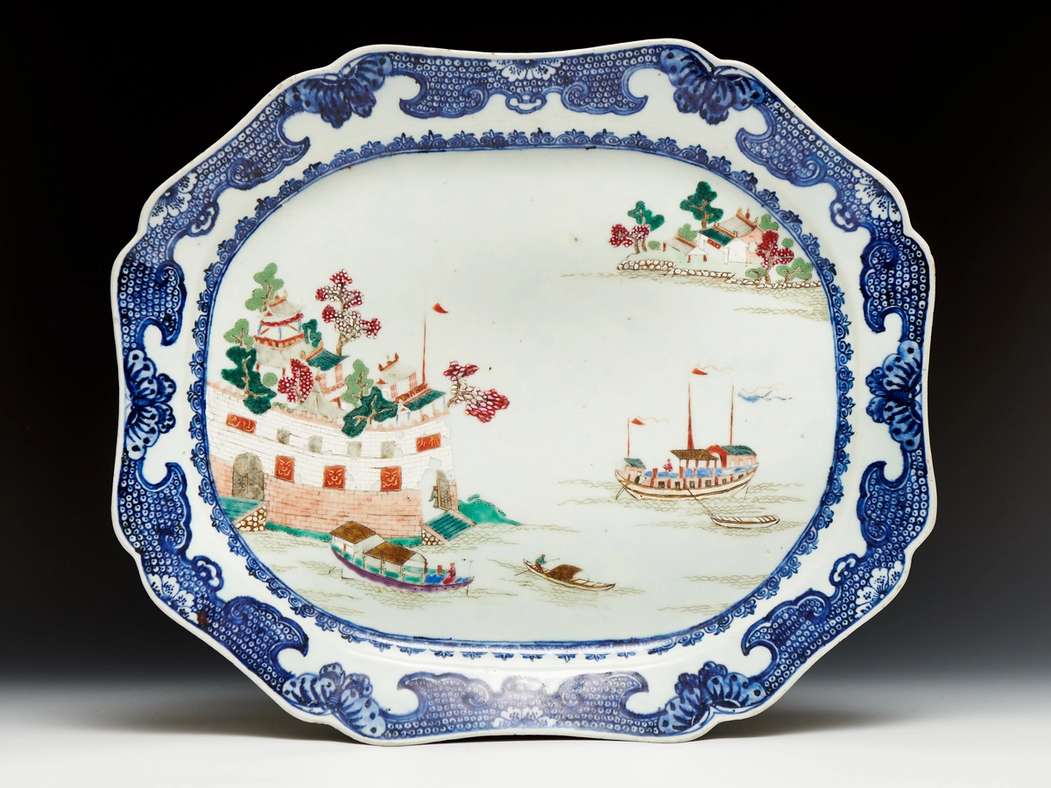Click the above image to zoom
Chinese porcelain dish decorated in opaque enamels from the famille rose (fencai) palette with the “Dutch folly fort”, Qianlong reign.
Sold
Stock Number: 5119
Massive meat dish with scalloped border in Chinese export porcelain decorated in opaque enamels from the famille rose (fencai) palette with the “Dutch folly fort”, c. 1780, Qianlong reign, Qing dynasty, 45,5x38x4,5 cm; 18x15x1¾ in. 4-18266
Literature:
• Porcelain and the Dutch China Trade, by C.J.A Jörg, 1982 The Hague, p. 70, cat. 18 for a saucer decorated in under-glaze cobalt blue;
• Kiinalaista Posliinia Suomessa, Chinese Porcelain in Finland, by H. Hyvönen, 1986 Finland, p. 147, cat. 262 for a dish decorated in opaque enamels.
◆ This and other forts were defensive structures built in the Ming dynasty to protect Guangzhou (Canton). By the beginning of the Qing dynasty the advances in cannonry made them redundant and had fallen into disrepair. Several European countries, including the French and the Dutch, used them for storage and as bases for the staff as the Europeans were not allowed to live in Guangzhou. The Dutch Folly fort was situated to the East of Guangzhou.
The Dutch folly fort was erected on a sand bank in the Pearl River close to the foreign factories in Guangzhou in a place said to be near a memorial temple to Li Maoying (1200-1257) of the Song dynasty.
中國外銷瓷粉彩葵口肉碟,盤內繪有「海珠砲台」,約1780年,清乾隆,45.5x38x4.5厘米;18x15x1¾吋。
參考文獻:
• 《荷蘭-中國貿易瓷》,作者C.J.A Jörg,1982年海牙出版,參見第70頁,編號18一件青花醬料碟;
• 《芬蘭的中國瓷器》,作者H. Hyvönen,1986年芬蘭出版,參見第147頁,編號262一件施不透明釉的瓷盤。
◆ 這類炮台建於明朝主要是用來防禦和保護廣州。清代早期,大炮的發明和使用取代了這類炮台,所以它們開始變得多餘,逐步疏於管理修復。幾個歐洲國家,包括法國和荷蘭,將這些炮台用於儲存和作為士兵的大本營。海珠砲台位於廣州東部。海珠砲台建在珠江邊的一個沙洲上,那裡不僅離廣州的外國工廠近,並且據說宋代李昴英紀念祠堂也在附近。


